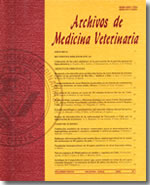Effects of the anaesthetic associations atropine-tiletamine/zolazepam and atropine-ketamine/diazepam on adult emus (Dromaius novaehollandiae)
Main Article Content
Abstract
In this study, the effects of the anaesthetic associations atropine IM (0.05 mg/kg)-tiletamine/zolazepam IV (4 mg/kg total) and atropine IM (0.05 mg/kg)-ketamine IV (5 mg/kg total)/diazepam (0.5 mg/kg) on physiological, anaesthetic and biochemical responses were determined on adult emus. Animals (n = 7 per group) were randomly assigned to the two anaesthetic associations. Variables were measured at baseline, during surgical plane and during 30 min of observation. Heart rate and temperature increased at the beginning of the experimental period (between 5-10 min, P = 0.001), while respiratory frequency and pulse decreased (between 5-15 min, P = 0.003). These patterns were detected with both anaesthetic associations. Anaesthetic induction and recuperation time were not affected by treatments (P = 0.12 and P = 0.13 respectively). Emus treated with tiletamine showed a greater anaesthetic time than emus treated with ketamine (P = 0.012). Significant increases in A.S.T. and glucose were observed at 24 h post application of anaesthetic associations, resulting higher in ketamine emus (P = 0.006 and P = 0.008 respectively). Finally, there were no significant differences between anaesthetic treatments for haemoglobin, total proteins and uric acid (P = 0.99, P = 0.97 and P = 0.81 respectively). In conclusion, atropine-tiletamine/zolazepam and atropine-ketamine/diazepam protocols resulted safe and efficient for animal manipulation, however the greater anaesthetic time observed in tiletamine-treated animals may determine preference for this anaesthetic combination.

